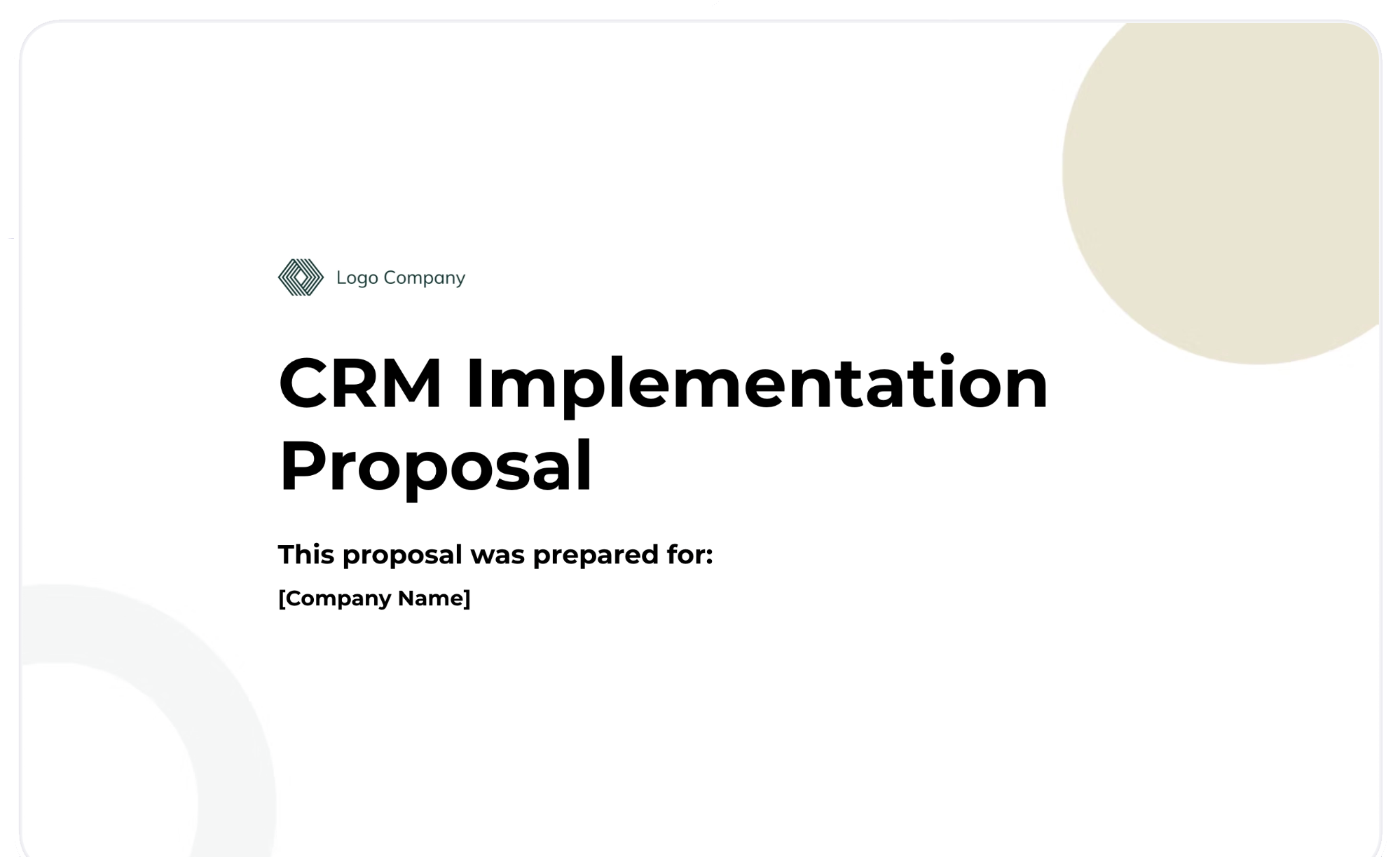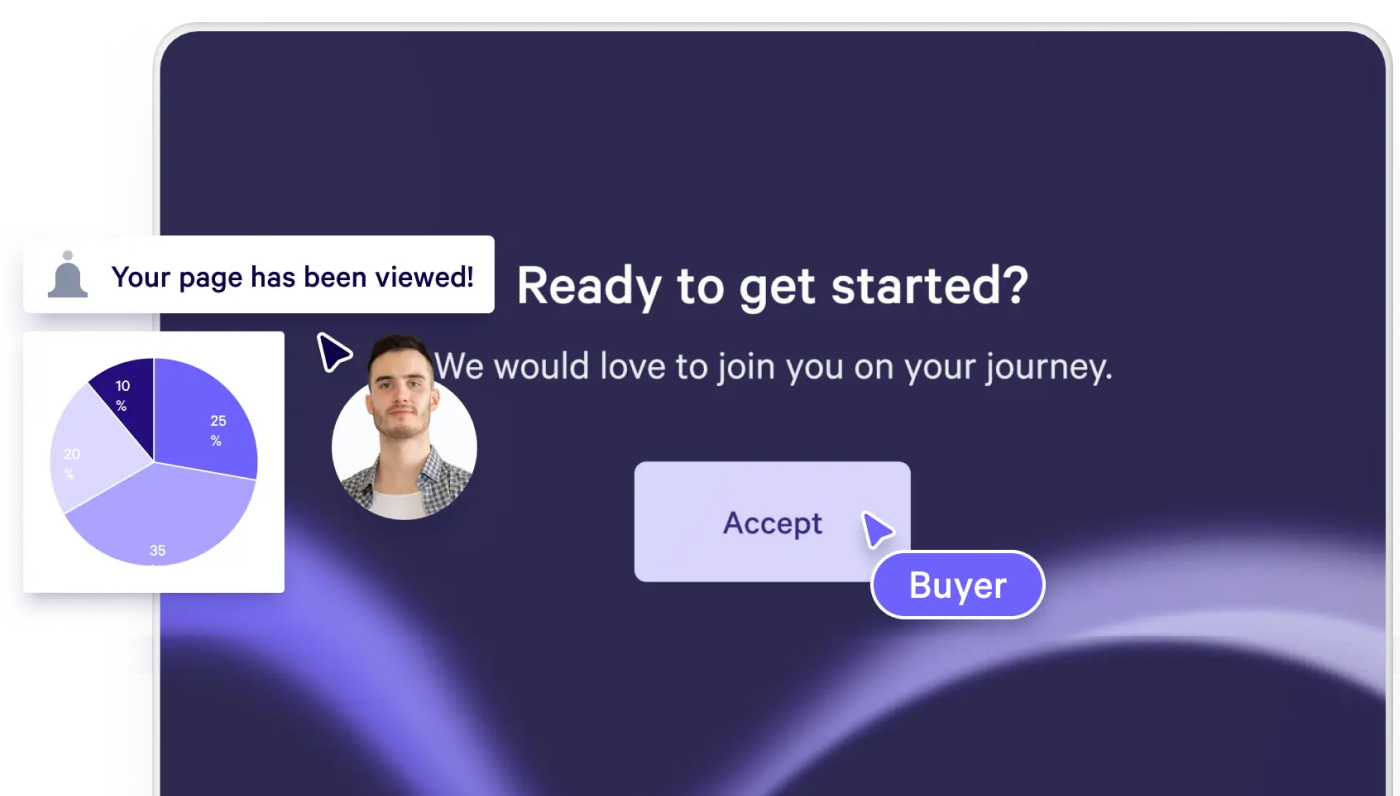
“Data is king” may be a well-worn cliche by now, but many businesses still don’t fully grasp what it means for them. Data is no longer just the byproduct of good housekeeping; it can be leveraged to power the very growth of the business.
And if you run a Customer Relationship Management agency, your CRM proposal is there to get this point across.
Writing the proposal is about finding the right balance. Of course, you need to toot your own horn about how good your system is, but always with a practical, customer-centric approach- this is what it will do for you. This is how it helps you reach your goals. You’re telling a story where they are the hero, and your CRM system is the trusty steed that helps them win the day.
With our guide, we’ve simplified the process. We've taken what we know and turned it into actionable steps to ensure that your offering doesn't just talk about the technical side of the CRM system but also addresses the real needs of your clients.
Key takeaways
- A CRM proposal should balance self-promotion with a customer-centric approach, focusing on how the system benefits the client.
- Understanding the client's needs and crafting a compelling introduction are crucial steps in writing a CRM proposal.
- The proposal should outline the problem, present a unique solution, detail the implementation plan, and showcase success stories.
- Pricing and terms should be explained clearly, linking costs to benefits.
- Personalization and proofreading are essential to ensure the proposal is logical, flows well, and stands out.
What is a CRM proposal?
A CRM proposal outlines what your CRM agency or consultancy can do and how it aligns with business needs when it comes to improving customer relationship management. It usually outlines a customized solution showing how CRM technology can change how a company works, sells, and communicates with its customers successfully.
This is your chance to show potential clients what services you offer. You also need to show them that these services are precisely what they need to achieve their goals and overcome their challenges.
While the features and functions of a CRM system are essential, they're only one piece of the puzzle. A CRM proposal's value is in showing that you understand the business you're talking to: "We know where you're coming from, we know where you're going, and we have the tools to help you get there."
If you'd like a visual representation of what this looks like, check out Qwilr's CRM Proposal Template.
Steps to write a CRM Proposal: Key elements to include
Writing the perfect CRM proposal means creating a document that reflects your understanding, strategy, and attention to detail. Here, we walk you through the must-haves when writing your sales proposal and the steps you need to take to put it together.
1. Understand your Client’s Needs
To understand your client, you need to do your homework. This means looking at the website, reading industry reports, and even social media to know how your client works. You're not just trying to find out what they do, but how they do it and why specific issues are a big headache for them. Really getting stuck into the nitty-gritty of their daily challenges and what it feels like to be in their position.
Your goal is to identify these problems and show how your CRM solution can solve them.
2. Craft a compelling introduction
Once you've got a good sense of their needs and CRM requirements, the next step is to start with an introduction that draws people in. Start with something that makes the reader sit up and take notice. Maybe it's an interesting fact, a thought-provoking question, or a story in which the readers can recognize themselves.
Then, tell them directly what you will talk about in your offer and why it's important to them. This is where you can show your confidence and expertise by explaining why your CRM solution is exactly what they were looking for and why they should be excited to learn more about it. Let your energy, enthusiasm, and investment in their project shine through.
3. Outline the problem statement
You'll use the problem statement to lay out your prospect's challenges (their main problem, if you will) and demonstrate your deep understanding.
Start by describing the challenges in simple language. Be specific here rather than making blanket statements about wanting better customer relations. Maybe their current system is so confusing that they're missing opportunities, and customers are unhappy. Or, they don't have the right data to get to know their customers or the resources to use those insights.
When discussing these problems, you must balance your expertise with your empathy. It's not about pointing fingers; it's about laying the groundwork for the solution you will offer.
4. Present your solution
Start by presenting your CRM solution in a way that clarifies why it's what the customer needs to solve their problems. Avoid sweeping generalities- their situation is unique, and your solution is unique.
For example, if their main issue is a disorganized system that causes them to overlook something, show how your CRM's user-friendly interface and automated processes can streamline their work. If they struggle to understand their customers, point out how your CRM's powerful data analytics tools can provide new insights.
When discussing what your CRM can do, be sure to link each feature to a benefit for the customer. Don't just mention that your CRM platform has advanced analytics, but also explain how these analytics can help the customer get to know their customers better.
5. Detail the implementation plan
Here, you explain how you'll put your plan into action. Start with a clear, step-by-step breakdown of how you will get your CRM up and running in their organization. This should include everything from CRM migration (transferring data into the new system) to training the team on using it.
Give timeframes and key moments so the client can visualize how things will work. For example, you could explain that you'll start with a review of the current system, set a timeline for the full integration of the CRM system, and then determine when training for the team will occur.
Remember to mention the support and help you'll offer throughout the process. Customers must know that they have your expertise and experience every step of the way.
6. Showcase success stories
In this part of your business proposal, it's time to show your clients concrete examples of how your CRM services have made a difference. Start by selecting stories or feedback that closely align with your customer's area or current challenges. These examples should show similar problems to the ones your client is struggling with and how you've helped them to improve the ways they manage their customer relationships and, ultimately, their business.
Focus on the changes you've made — compare before and after improvements. For example, if you're talking to a store owner, tell them about another store where the customer response rate increased after using your CRM.
Each success story should include data like specific numbers and tangible results to support your claims. Mention how much sales or customer satisfaction has increased and how much time has been saved.
7. Explain your pricing and terms
Start by explaining in a simple way how much your CRM will cost. Break down any packages or options you offer and explain exactly what each includes. Be sure to link the costs to the benefits they bring.
For example, if you have different service levels that offer advanced data analysis, explain exactly how each level helps you better understand your customers and increase sales.
Then, go into the terms and conditions that you require. Talk about how long the contract runs, what kind of support and updates they'll receive, and what promises or guarantees you'll make. If there are rules for terminating the contract early or changing the scope of services, you should clarify these here.
8. Proofread and personalize
Proofreading isn't just about finding spelling or grammatical errors; it's also about ensuring the entire proposal is logical and flows well. Reading aloud is useful for picking up the rhythm here- how it sounds and what it says. It's your job to check that each part of the proposal fits perfectly with the next and backs up your argument that your CRM is the right choice for them.
It's the personalization of your proposal that makes it stand out, and extra effort here will really help distinguish your offer. Make it clear you're speaking directly to the customer with an offer tailored like a Saville Row suit.
Example of a CRM proposal template
Getting started creating your CRM or CRM Services Proposal may seem a bit overwhelming, but there's an easier way. Qwilr's CRM Proposal Template gives SaaS companies and agencies a great starting point to create proposals that stand out. It's designed to simplify your job by providing a clear and easily customizable layout. This lets you get a personalized proposal in front of them in no time - leaving you more time to do what you do best: implement or optimize CRM systems.
The sales proposal template comes fully loaded with the following sections:
- Executive Summary: Here, you offer a warm welcome and preview the topics you'll cover. For non technical stakeholders, they should be able to read this section and get the gist of your proposal.
- Understanding Your Needs: This part gets into the heart of what your client is dealing with. You show that you get the challenges and what they aim to achieve, proving that you're truly in tune with their situation.
- Your Priorities: Here, you highlight what's most important to your client. You clarify that their main goals are leading the way for your planning.
- Success Looks Like: In this section, you sketch how success will appear once your CRM is part of their operation. This step is crucial for showing them a promising future and growth.
- Our Approach: You explain your strategy for meeting your client's needs, covering the methods and tools you bring. You stress how your CRM is specially designed to address the specific hurdles your client faces.
- Our Services: You dive deep into what you're offering, breaking down the ins and outs of your CRM's features, how they're built to help your client overcome their challenges and make their job easier.
- Our Achievements: You tell stories of how you've helped other businesses in similar situations, providing solid examples of your past successes. This part is vital for showing you can do what you say you can.
- Our Team: You introduce your client to the team members behind the scenes, highlighting their expertise and drive to make a difference. This reassures your clients that they're in good hands.
- Investment Required: This is where you're completely upfront about the cost of your CRM. You should emphasize how important it is for your clients to see the real value they're getting.
- CTA (Call to Action): You encourage your client to take the next step, whether it's a meeting, a demo, or a chat about how your CRM can benefit them.
- Conclusion: You wrap things up by reminding your clients that choosing your CRM is more than a smart business decision; it's a step towards the success they're after. It's your final word on how committed you are to working with them for a brighter future.
Alternatively, try our AI proposal generator to create your own proposal template in minutes.
Final Thoughts
Writing a good CRM proposal is about showing that you understand the customer's problems, have the expertise to solve them, and can provide proof that your solutions work. Follow those tips and this guide and you’ll be well on your way.
If you're looking for a place to start, check out Qwilr's CRM proposal template. It helps save you time creating branded proposals designed to impress and then convert.
About the author

Brendan Connaughton|Head of Growth Marketing
Brendan heads up growth marketing and demand generation at Qwilr, overseeing performance marketing, SEO, and lifecycle initiatives. Brendan has been instrumental in developing go-to-market functions for a number of high-growth startups and challenger brands.
Frequently asked questions
The ideal Customer Relationship Management (CRM) proposal format is simple, well-organized, and tailored to your client's needs. It should start with an engaging introduction, clearly outline the customer's challenges, and give a detailed insight into your CRM strategy and how it solves those problems. End with a compelling call to action and a conclusion that convinces your client of the positive impact of your CRM.
To make your CRM consulting proposal stand out, demonstrate a deep understanding of the client's business challenges and how the CRM plan specifically addresses those issues. Include case studies or testimonials from past clients to showcase your track record of successful implementations. Personalizing the proposal to reflect the potential client's branding and language can also make a big difference.
Often, CRM initiatives fail when salespeople don't adequately research the client's business and offer a generic solution that doesn't address specific needs or challenges. Overlooking the importance of user adoption and engagement strategies in the proposal can also be a pitfall, as these are critical to the success of any CRM strategy.




